8 - Women’s Participation in Small Island Resilience Building in Concepcion, Iloilo, Philippines
Published online by Cambridge University Press: 18 January 2024
Summary
Background
This chapter discusses women's contribution to community resilience through social entrepreneurship (SE) and social enterprises (SEs). The need to support entrepreneurial activities in boosting economic conditions, especially with the participation of women, clearly demonstrates a crucial element in the building back better (BBB) approach. Likewise, a thorough understanding of how women have been supporting local economic development and rehabilitation in disaster-prone communities was also examined. This may contribute relevant insights to the theory and practice of entrepreneurship and gender studies, as it describes the roles of women and the relationships of various actors in disasters. It has value added in the SE literature as this chapter contributes to further strengthening of empirical approaches in the field.
In terms of disasters, communities residing on small islands are more exposed and vulnerable compared to mainland communities. Moreover, the availability and accessibility of institutional support and assistance in these areas are some of the most common issues among people living on the island. Layers of marginalization can be observed from socioeconomic issues (e.g., poverty, alternative livelihood), to environmental constraints (e.g., natural hazards). Thus, this study focused on small island resilience building.
Gender in disaster and resilience studies has been gaining interest among scholars from various fields (Fordham, 1998; Nguyen, 2019). In particular, the work of Enarson (1998) and Bradshaw (2013) posit gender in disaster research agendas, while its development in the literature can be explored still further. As disasters generate casualties in terms of lives and properties, it disempowers different groups and sectors in the community. This is especially noticeable among women as one of the vulnerable groups (Enarson 2000). The vulnerability of women amidst disasters has been elevated on different levels of discourse through time. Some have argued that women's vulnerabilities can be positioned in a broader spectrum of defenselessness to having the capacity to bounce back (Islam et al 2017). Beck (2005) has made a valid observation pointing out that women's contributions in disaster recovery are often ignored, and that most of the rebuilding initiatives are male-dominated, focusing much on infrastructure and physical development rather than socio-economic interventions.
- Type
- Chapter
- Information
- Disasters in the PhilippinesBefore and After Haiyan, pp. 155 - 178Publisher: Bristol University PressPrint publication year: 2023



